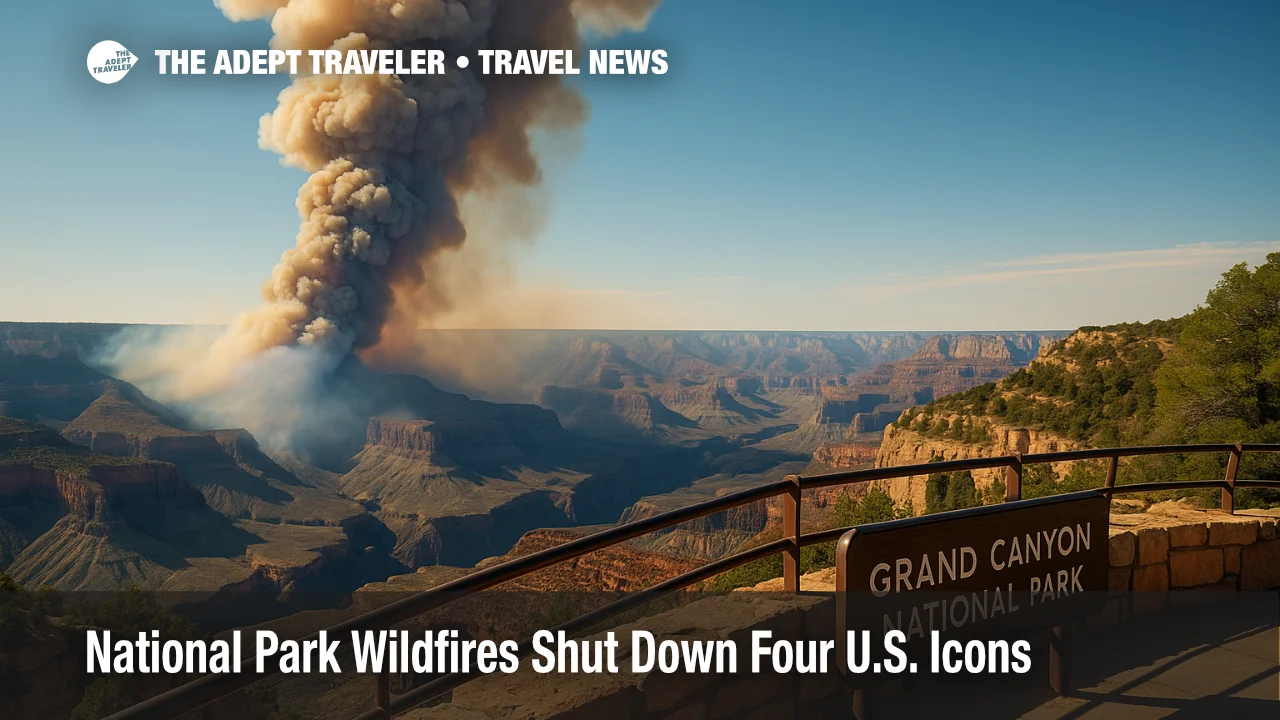National Park Wildfires Shut Down Four U.S. Icons

Grand Canyon's Dragon Bravo megafire has already erased its century-old North Rim lodge, Olympic's Bear Gulch blaze is fouling air over Washington's Hood Canal, and smaller lightning-sparked fires now constrain access at Colorado's Black Canyon of the Gunnison and Wyoming's Yellowstone. Visitors planning August trips-the peak of what fire crews dub "Dirty August"-face partial closures, hazardous smoke, and shifting itineraries. The National Park Service (NPS) warns that more closures are possible as resources stretch thin and record-dry landscapes invite fast-moving flames.
Key Points
- Why it matters: Four marquee parks are limiting access at the height of the summer travel season.
- Travel impact: Smoke can trigger "trip delay" benefits when flights are grounded for low visibility.
- What's next: Containment hinges on cooler weather; travelers may need plan B parks through Labor Day.
Snapshot
As of August 2, 2025, the lightning-caused Dragon Bravo Fire has scorched more than 111 000 acres on Grand Canyon's North Rim, destroying about 70 structures-including the historic Grand Canyon Lodge-and closing the entire developed area for the rest of the year. In Washington, the human-caused Bear Gulch Fire has surpassed 3 000 acres; Mason County officials have issued Level 3 "Go" evacuations while NPS bans all campfires and urges visitors to monitor smoke forecasts. Colorado's South Rim, roads, and campgrounds at Black Canyon remain off-limits pending hot-spot patrols, while Yellowstone firefighters are holding a ten-acre Ash Fire spotted July 30 near the southwest boundary.
Background
Fire managers call August "dirty" because regional seasons now overlap, stretching resources and exposing infrastructure built for milder decades. The Park Service's long-standing "confine and contain" strategy, designed to let low-intensity fires rejuvenate ecosystems, has struggled amid hotter, windier conditions. Seasonal staffing-common at remote parks-compounds the challenge; agencies report vacancy rates above 20 percent. Advocates argue that pay and housing incentives plus more permanent crews are essential as climate-driven megafires become routine.
Latest Developments
Grand Canyon North Rim Lodge Lost
Flames breached protective lines on July 13, leveling the 1928 lodge, visitor center, and multiple cabins. Arizona's governor ordered a review of initial tactics after gusty winds pushed the fire beyond containment and into historic structures. State Route 67 remains closed, and all lodging reservations have been canceled or refunded. Travelers can reroute to Petrified Forest National Park or Vermilion Cliffs National Monument, both currently unaffected.
Smoke Advisories Cloud Olympic Plans
Bear Gulch's rugged terrain is producing daily inversion layers that trap particulate haze over Lake Cushman and the Staircase area. Mason County health officials warn that air-quality indices can swing from "moderate" to "unhealthy" within hours. North Cascades National Park and Washington's lesser-known San Juan Islands National Monument offer clearer skies this weekend, according to state air-quality dashboards.
Small but Stubborn Fires in Black Canyon, Yellowstone
In Colorado, crews hope to reopen the North Rim on August 5 if weather cooperates, but the popular South Rim Drive is CLOSED until snags can be felled. In Wyoming, the Ash Fire's containment line is holding, yet fire-weather watches persist. Day-trippers can pivot to Curecanti National Recreation Area or Bighorn Canyon National Recreation Area for similar canyon scenery without current restrictions.
Analysis
For travelers, wildfire smoke matters as much as flame. Most comprehensive travel-insurance policies treat smoke-related ground stops like storm delays. If a common carrier postpones departure for three to twelve hours-policy-specific minimums-"trip delay" benefits can reimburse meals, lodging, and unused prepaid costs. Some plans also cover additional transport to reach a tour mid-itinerary once airspace reopens. However, coverage applies only if the policy predates the fire's "known event" status; buying insurance today will not help with Dragon Bravo disruptions declared in July.
Parks adjacent to closures may enjoy a visitor bump, but rural gateways lack spare beds. Advisors recommend booking cancellable rooms in Flagstaff, Port Angeles, Montrose, or Cody and watching NPS alert feeds daily. Adventurous travelers can seek quieter units such as Arizona's Walnut Canyon, Colorado's Florissant Fossil Beds, or Wyoming's Shoshone National Forest-each offering ranger programs, dark skies, and hiking without current smoke alerts. Long-term, experts say the Park Service must retool staffing models, expand prescribed-burn windows, and harden historic structures to preserve visitor access amid intensifying national park wildfires.
Final Thoughts
Wildfire season now reliably overlaps with the busiest U.S. vacation month, forcing quick itinerary pivots and underscoring the value of pre-purchased, flexible coverage. Until cooler, wetter patterns return, travelers should keep an eye on NPS updates, build extra buffer days, and consider underrated nearby preserves where the views still dazzle-minus the smoke. Careful planning today will help you stay ahead of the next wave of national park wildfires.
